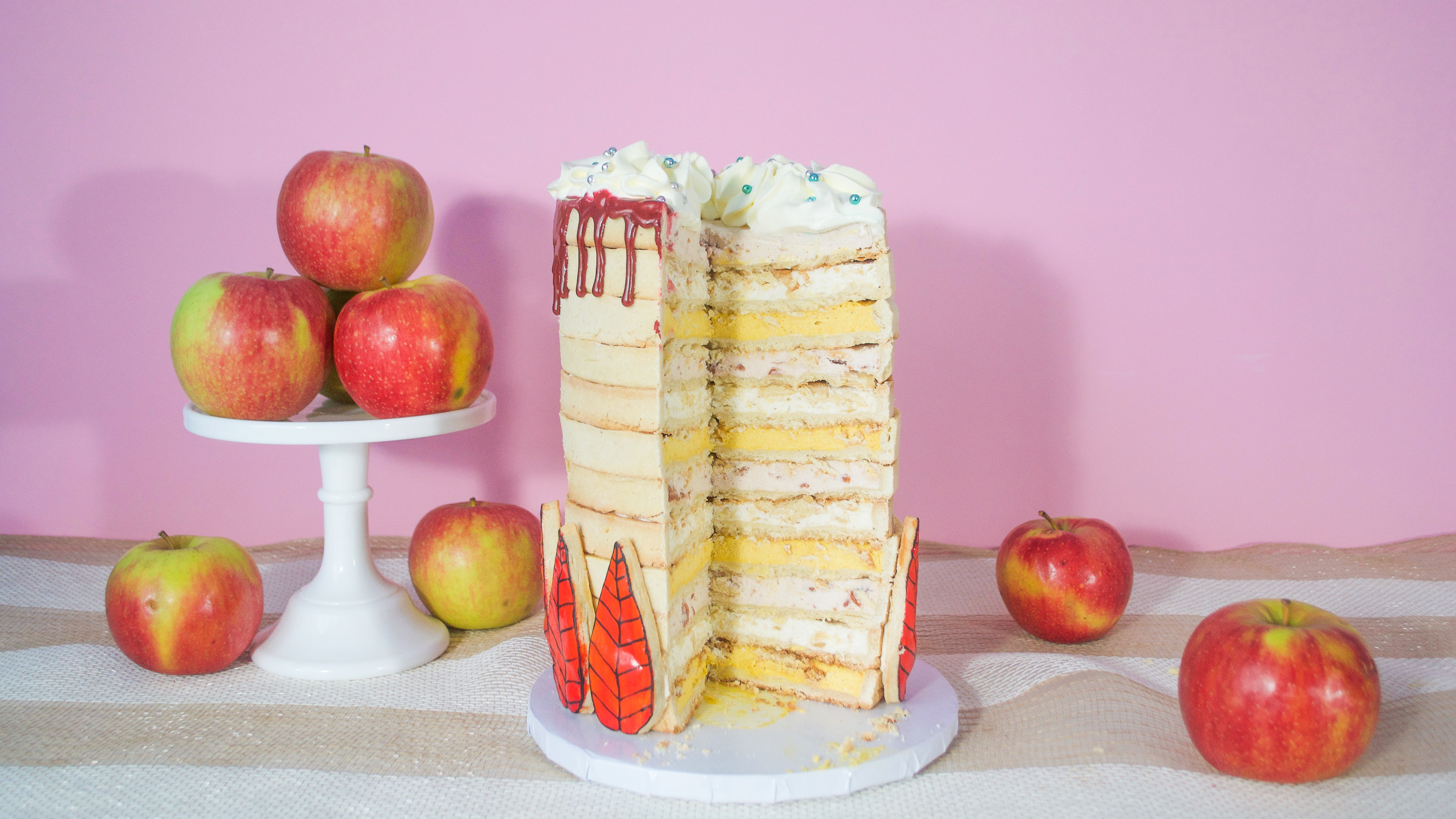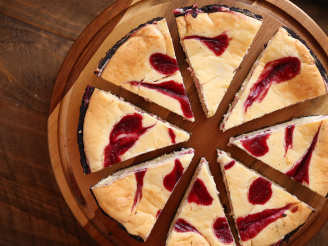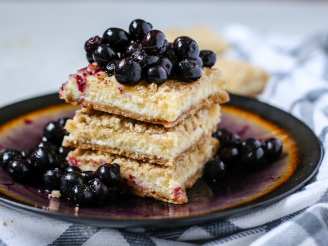Cheesecake (Cook's Illustrated)

- Ready In:
- 2hrs 45mins
- Ingredients:
- 10
- Yields:
-
1 cheesecake
- Serves:
- 12
ingredients
- 14.79 ml unsalted butter, melted
- 44.37 ml graham cracker crumbs
- 4 (907.18 g) package cream cheese, at room temp
- 295.73 ml granulated sugar
- 4 large eggs, at room temp
- 4.92 ml lemon zest or 9.85 ml lemon juice
- 9.85 ml vanilla extract
- 59.14 ml heavy cream
- 59.14 ml sour cream
- 0.25 ml salt (optional)
directions
- Rich and Creamy.
- Preheat oven to 325 degrees F.
- Set a large tea kettle of water to boil.
- Use a 9-inch springform pan. Tear off a rectangular piece of 18-inch aluminum foil, and wrap it underneath the springform bottom and fold up along sides of pan, creating a water-tight barrier. It's a good idea to use a second piece of foil to ensure water tightness.
- Inside the pan, brush bottom and sides with melted butter. Drop in crumbs, and tilt the pan around to coat bottom and sides with crumbs evenly.
- Grate teaspoon of zest off lemon. Place zest and 1/4 cup sugar in food processor and pulse until sugar turns slightly yellow, mixing its oils with sugar. If zest isn't available, just put 2 teaspoons of lemon juice in batter.
- Beat cream cheese until smooth. Add sugar and zest-sugar to cheese and beat about 3 minutes on low speed.
- Add eggs one at a time and beat until incorporated. Add vanilla extract, mix. Add heavy cream, mix. Add sour cream, mix. I usually add an optional pinch of salt. After ensuring all ingredients are mixed evenly and thoroughly, pour mixture into the prepared pan.
- Place springform pan into a roasting pan. (A disposable aluminum one works just fine.).
- Place roasting pan on middle rack in oven, securely, and pour enough boiling water to go half way up side of springform.
- Bake for 55-60 minutes. Doing the jiggle test: gently shaking the springform pan, the outside of cake will appear firm but the center will jiggle like Jell-O, and the top will not look browned, thus giving the appearance that it is underdone. But this is what you want because the hot cheesecake will continue to cook.
- Turn off oven. Use a wooden spoon to open keep the oven door ajar a couple inches in order to cool. Leave cheesecake in oven for an hour.
- Remove springform pan from roasting pan, place on rack on counter to cool to room temperature for 2-4 hours.
- Using dental floss, cut even serving slices in the cheesecake before refrigeration. The floss ensures crisp edges and doesn't stick like a knife.
- Cover and refrigerate for at least four hours or overnight. (It always tastes better the next day.).
- The cheesecake can be refrigerated for up to 4 days, but it won't last that long--trust me.
- Light and Airy.
- Follow the above recipe, but separate the eggs. Add only yolks when instructed to add eggs. After adding creams, beat egg whites until stiff, fold into batter, and follow the rest of the instructions. Bake 45-50 minutes.
- Firm and Dense.
- Follow the above recipe, but don't use a water bath. Preheat oven to 500 degrees F. Bake cheesecake at 500 F for 10 minutes, then reduce temperature to 200 degrees F, and prop oven door open about 12 inches with a wooden spoon for about a minute, until temperature reduces in oven. Close oven door and bake approximately 60 minutes, until the cake jiggles in the center as above. Follow the same cooling instructions.
Questions & Replies
Got a question?
Share it with the community!
Reviews
-
The Firm and Dense version is impractical. I've never seen an oven that beeps when the temperature has LOWERED to a set point; it only beeps when the preheating has RAISED the temperature to the set point. And leaving the door "ajar" while waiting for the oven to go from 500 degrees down to 200 degrees would take a LONG time. It's almost like you'd have to yank it out of a 500-degree oven and swap it to one preheated to the lower setting. And how many people have access to two ovens in their kitchens (although, now that I think about it, we had two ovens in our kitchen when I was a kid, one with the stove and one in the wall)? I really don't see how this would work. If there are more specific instructions to tell how to accomplish this, they aren't showing herein.
RECIPE SUBMITTED BY
<p>I like to cook.</p>
<p>Surprise. Who'd have expected that on a cooking website? </p>
<p>Cooking, like any art, is about joy and self-expression. When you make something that others enjoy, and they get it, you feel a connection with them. When you create something new, you're filled with a sense of accomplishment. If you're not joyful, then you're not doing it right. Follow your passion, and it will always lead you in the right direction. </p>
<p>The term chef isn't really accurate when applied to me. I never went to the Cordon Bleu nor studied at C.I.A. I'm someone who cooks as a hobbiest. If it tastes good, I eat it. If it's bad, it goes in the garbage. </p>
<p>I am a fan of the older cookbooks by James Beard and Robert C. Ackart, and I have to admit that their influence has been very formative of my tastes. It is my fond hope that by posting some recipes from their excellent books that their dishes will continue to be of interest to fellow cooks in the future, both young and old, rather than perishing in obscurity. I like a satisfying casserole more than anything, hand-made loaves of freshly baked bread, cooking with wines and liqueurs, but I am also very fond of elegant desserts, and some of my very favorites appear here on this website. </p>
<p>Slowly, as I make them, I will add photographs of the dishes since a picture is worth a thousand words. I want to apologize in advance for the quality of the photos, however, as I'm not a gifted photographer, and many of the dishes will appear unappetizing, but they are actually very good. </p>
<p>Here are some of my favorite cookbooks that I have drawn a great deal of guidance and inspiration from over the years, and I sincerely hope that others will find copies of these older but substantial books through venues like Ebay, Half.com and Amazon and get as much satisfaction from them as I have. The recipes that I post from these books have been improved upon with my own ideas, so as not to violate any copyrights. </p>
<p>Ackart, Robert. <span>Cooking in a Casserole</span>. </p>
<p>Ackart, Robert. <span>The One-Dish Cookbook</span>. </p>
<p>Ackart, Robert. <span>A Celebration of Soups</span>. </p>
<p>Beard, James. <span>The New James Beard</span>. </p>
<p>Beard, James. <span>Beard on Bread</span>. </p>
<p>Ruhlman, Michael. <span>Ratio</span>. </p>
<p><span>Cook's Illustrated Cookbook</span>. </p>
<p> </p>
<p>I hope that some of these recipes find their way into your stomach and your heart. </p>
<p>Enjoy. </p>




